 |
| |
 |
| |
Backscattered Electron Imaging
Do
You Know Everything We Do?
MEi President
on Careers CD
MEi Briefs
The
Lighter Side
Ann Landers: On Product Safety!
The "What Is It?" Contest |
What
It Is and What It Can Do For You
 While most of us
have been exposed to or are familiar with the scanning electron microscope
(SEM) as a powerful tool for failure analysis and contamination identification,
you may not be familiar with the use of the SEM in the back-scatter
image analysis mode, commonly referred to as BEi or simply back-scatter. While most of us
have been exposed to or are familiar with the scanning electron microscope
(SEM) as a powerful tool for failure analysis and contamination identification,
you may not be familiar with the use of the SEM in the back-scatter
image analysis mode, commonly referred to as BEi or simply back-scatter.
What is it?
 In normal mode,
the SEM creates an image by gathering the low energy secondary electrons
which are ejected from the atoms within the sample. In the back-scatter
mode, high energy electrons from the incident beam "bounce"
off the atoms of the sample and are gathered. The intensity of the
image is related to how many electrons bounce off or are scattered
back, hence the term back-scattered. The heavier elements, such as
tungsten and molybdenum, have larger nuclei and thus have a higher
probability of creating back-scattered electrons. The energy of back-scattered
electrons does not vary with the element, only with the operating
voltage of the SEM. In normal mode,
the SEM creates an image by gathering the low energy secondary electrons
which are ejected from the atoms within the sample. In the back-scatter
mode, high energy electrons from the incident beam "bounce"
off the atoms of the sample and are gathered. The intensity of the
image is related to how many electrons bounce off or are scattered
back, hence the term back-scattered. The heavier elements, such as
tungsten and molybdenum, have larger nuclei and thus have a higher
probability of creating back-scattered electrons. The energy of back-scattered
electrons does not vary with the element, only with the operating
voltage of the SEM.
In the conventional
SEM photo (left) the metal shaving all look alike. However, the contrast
difference in the backscatter image (right) reveals the shavings are
a misture of three different metals.
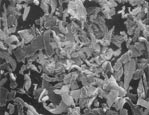  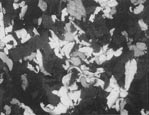
 45X 45X 45X
45X
What does this really mean?
 The information
provided by each mode is dramatically different. In the normal secondary
electron mode, the contrast observed is due primarily to topography,
and is generally rather low. In the back-scatter mode, the contrast
observed is due to differences in atomic number. The high atomic number
elements (e.g. molybdenum, tungsten and lead) appear bright in contrast
to the low atomic number elements (e.g. aluminum, silicon and titanium). The information
provided by each mode is dramatically different. In the normal secondary
electron mode, the contrast observed is due primarily to topography,
and is generally rather low. In the back-scatter mode, the contrast
observed is due to differences in atomic number. The high atomic number
elements (e.g. molybdenum, tungsten and lead) appear bright in contrast
to the low atomic number elements (e.g. aluminum, silicon and titanium).
Uses of BEi
 Back-scatter allows
for quick and easy identification of phases with different elemental
compositions. What does this mean in a practical sense? In a tool
steel, the tungsten and molybdenum carbides appear brighter than chromium
carbides, permitting quick differentiation. In leaded bronze, a segregation
of the lead phase within the structure stands out against a dark background.
Heavy metal platings appear white on a fracture surface, providing
insight into whether a crack occurred in manufacturing prior to plating,
or during usage. Back-scatter allows
for quick and easy identification of phases with different elemental
compositions. What does this mean in a practical sense? In a tool
steel, the tungsten and molybdenum carbides appear brighter than chromium
carbides, permitting quick differentiation. In leaded bronze, a segregation
of the lead phase within the structure stands out against a dark background.
Heavy metal platings appear white on a fracture surface, providing
insight into whether a crack occurred in manufacturing prior to plating,
or during usage.
 The photographs show a group of metal shavings. In the conventional
SEM photograph, all the shavings appear the same shade of gray. However,
in back-scatter imaging, the shavings appear as bright, gray, and
dark. EDS analysis confirms the shavings to be a mixture of aluminum
(dark), steel (gray) and silver plating (bright).
The photographs show a group of metal shavings. In the conventional
SEM photograph, all the shavings appear the same shade of gray. However,
in back-scatter imaging, the shavings appear as bright, gray, and
dark. EDS analysis confirms the shavings to be a mixture of aluminum
(dark), steel (gray) and silver plating (bright).
Summary
 Back-scattered
electron imaging is a good complement to conventional secondary electron
imaging on the scanning electron microscope, and is a powerful tool
for certain applications. If you have a materials processing problem
that you think back-scatter imaging would be the ideal tool to help
you resolve, just give us a call to discuss the possibilities. Back-scattered
electron imaging is a good complement to conventional secondary electron
imaging on the scanning electron microscope, and is a powerful tool
for certain applications. If you have a materials processing problem
that you think back-scatter imaging would be the ideal tool to help
you resolve, just give us a call to discuss the possibilities.


 While
many of our customers have worked with us on several projects through
the years, we are sure that some of our customers may not be familiar
with the full range of services we offer. Hopefully, this list will
give you a better idea of the range of services we offer. As always,
we have an open invitation for any of our customers to come to Virgil
to see how we do things. While
many of our customers have worked with us on several projects through
the years, we are sure that some of our customers may not be familiar
with the full range of services we offer. Hopefully, this list will
give you a better idea of the range of services we offer. As always,
we have an open invitation for any of our customers to come to Virgil
to see how we do things.
Our Services |
Failure
Analysis
• Wear
• Fatigue
• Corrosion
• Hydrogen Embrittlement
• Ductile or Brittle Overload
• Improper Design or Misuse
• Material & Processing Defects Contamination
Identification
• Residues and Surface Films
• Corrosion Products
• Wear Debris
• Particles
• Plating & Joining Adhesion Problems
• Electronics, Medical Contaminants
Complete Metallurgical Laboratory
• Scanning Electron Microscopy
• EDS Chemical Analysis
• Metallography and Microscopy
• Microhardness and Hardness |
Analysis
of Processing Problems
• Welding, Brazing and Soldering
• Stamping and Metal Forming
• Casting and Forging
• Plating and Coating
• Heat Treating
• Powder Metal
Engineering Services
• Design Support
• Materials Selection
• Problem Analysis & Corrective Action
• Materials and Process R&D
We Also Provide
• On Site Investigations
• Specialized Product Testing
• Expertise in Electronics, Ceramics & Polymers
• Product Liability Investigations
• Expert Testimony |
And Tensile strength, chemical composition, FTIR, physical properties
and
Tensile strength, chemical composition, FTIR, physical properties
and
corrosion testing are available though our network of associated laboratories.


 Last
spring, video production specialist Elizabeth Hogan of Ruder-Finn
in New York City spent a day at the MEi facility in Virgil, Illinois
interviewing Bill Durako about Careers in Metallurgy and Materials
Engineering. The interview is part of a project called the Career
Resource Center (CRC) being developed by TMS-AIME for the materials
engineering profession. Last
spring, video production specialist Elizabeth Hogan of Ruder-Finn
in New York City spent a day at the MEi facility in Virgil, Illinois
interviewing Bill Durako about Careers in Metallurgy and Materials
Engineering. The interview is part of a project called the Career
Resource Center (CRC) being developed by TMS-AIME for the materials
engineering profession.
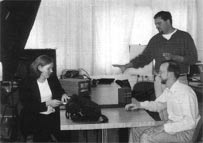  The
CRC project is funded by the Arthur P. Sloan Foundation. It features
interviews and comments with professionals in a variety of technical
professions, including materials, mechanical, electrical, chemical
and civil engineering, as well as physics, chemistry, geology and
mathematics. The
CRC project is funded by the Arthur P. Sloan Foundation. It features
interviews and comments with professionals in a variety of technical
professions, including materials, mechanical, electrical, chemical
and civil engineering, as well as physics, chemistry, geology and
mathematics.
 The
project is targeted primarily at high school students. The goal of
the project is 'to build public awareness of Science and Engineering
fields and to provide students with comprehensive information with
which to make informed academic and career decisions.' The
project is targeted primarily at high school students. The goal of
the project is 'to build public awareness of Science and Engineering
fields and to provide students with comprehensive information with
which to make informed academic and career decisions.'
TMS of AIME was selected to develop the Materials Science and Engineering
portions of the CRC, and hopes to use the project to demonstrate the
many opportunities available to students studying materials engineering.
 The completed project
will consist of an interactive CD ROM to be distributed to high schools
and universities, a World Wide Web site that will offer a wealth of
academic and statistical information, and an accompanying booklet
for student distribution listing key facts on accredited university
science and engineering programs, and course requirements. The high
tech interactive presentation is full of examples aimed at being entertaining
as well as informative. The multimedia format will feature Quicktime
video clips with practicing engineers. Bill Durako is one of these
so called 'Featured Engineers'. The completed project
will consist of an interactive CD ROM to be distributed to high schools
and universities, a World Wide Web site that will offer a wealth of
academic and statistical information, and an accompanying booklet
for student distribution listing key facts on accredited university
science and engineering programs, and course requirements. The high
tech interactive presentation is full of examples aimed at being entertaining
as well as informative. The multimedia format will feature Quicktime
video clips with practicing engineers. Bill Durako is one of these
so called 'Featured Engineers'.
 The
interview covered everything from a typical day and the most enjoyable
aspects of the job, to how he decided to pursue the career path and
what advice he would give to others interested in this field. Both
the CD-ROM and World Wide Web site feature "Live from the Home
Offices in Virgil, IL: Bill's Top Ten List of Things to Assist You
in Your Engineering Career." The
interview covered everything from a typical day and the most enjoyable
aspects of the job, to how he decided to pursue the career path and
what advice he would give to others interested in this field. Both
the CD-ROM and World Wide Web site feature "Live from the Home
Offices in Virgil, IL: Bill's Top Ten List of Things to Assist You
in Your Engineering Career."
 The
CD-ROM is in the final stages of production and is scheduled to be
released this summer. The world wide web site has many of the features
completed, but is still under construction. You can check on the progress
at www.crc4mse.org. The
CD-ROM is in the final stages of production and is scheduled to be
released this summer. The world wide web site has many of the features
completed, but is still under construction. You can check on the progress
at www.crc4mse.org.
 "I enjoyed being a part of this project. I know many high school
students struggle with what they want to do with their lives. It's
tough to make a decision without information. So many people either
have a misunderstanding of what engineers do, or are pushed into engineering
because they are good at math and science. Hopefully, the CRC CD-ROM
and web site will provide insight into what engineers and scientists
actually do, and help students with their career decisions."
"I enjoyed being a part of this project. I know many high school
students struggle with what they want to do with their lives. It's
tough to make a decision without information. So many people either
have a misunderstanding of what engineers do, or are pushed into engineering
because they are good at math and science. Hopefully, the CRC CD-ROM
and web site will provide insight into what engineers and scientists
actually do, and help students with their career decisions."


 Our
customers will notice a self addressed stamped feedback card enclosed
in many of our reports, especially to newer customers. The card contains
9 simple questions for you to evaluate our performance. We want to
know what you think of your experience working with us. We are not
the biggest in our field, but we are striving to be the best. Our
goal is complete customer satisfaction, and the feedback cards are
one way to help us get there. Our
customers will notice a self addressed stamped feedback card enclosed
in many of our reports, especially to newer customers. The card contains
9 simple questions for you to evaluate our performance. We want to
know what you think of your experience working with us. We are not
the biggest in our field, but we are striving to be the best. Our
goal is complete customer satisfaction, and the feedback cards are
one way to help us get there.
 One
of the questions asks if you would like to meet with MEi engineers
to discuss other materials and processing issues. We know that nothing
can replace the meeting across the table to better understand your
needs and our capabilities. We have many customers whom we meet with
routinely as part of our projects with them, and we know that this
has been a very effective tool. However, we know that this is not
always possible, especially for many of our customers from coast to
coast. Our goal this year is to visit more of you, our customers at
your facility. And as always, you are always welcome to come to Virgil. One
of the questions asks if you would like to meet with MEi engineers
to discuss other materials and processing issues. We know that nothing
can replace the meeting across the table to better understand your
needs and our capabilities. We have many customers whom we meet with
routinely as part of our projects with them, and we know that this
has been a very effective tool. However, we know that this is not
always possible, especially for many of our customers from coast to
coast. Our goal this year is to visit more of you, our customers at
your facility. And as always, you are always welcome to come to Virgil.


 In
case you've ever wondered why ignorance rises to the executive level,
here is a simple explanation that is also mathematical proof: In
case you've ever wondered why ignorance rises to the executive level,
here is a simple explanation that is also mathematical proof:
Knowledge is Power. Time is Money.
And, as every engineer knows: Power=Work/Time
If Knowledge=Power and Time=Money, then
Knowledge=Work/Money
Solving for Money, we get
Money=Work/Knowledge
Thus, Money approaches infinity as Knowledge approaches zero, regardless
of the work done. What this means is: The less you know, the more
you make!


 Dear Ann Landers:
The warning from "Careful in Colombia, MD.," to disconnect
microwaves when not in use applies to other small appliances as
well. Please print this letter. I wish I had seen one like it. Dear Ann Landers:
The warning from "Careful in Colombia, MD.," to disconnect
microwaves when not in use applies to other small appliances as
well. Please print this letter. I wish I had seen one like it.
 One afternoon
when no one was home, my house sustained $42,000 worth of damage
from a fire started by a defective toaster oven. The oven, which
was only 3 years old, was not in use but was plugged in. The insurance
company that paid the cost of rebuilding the house brought a claim
against the toaster oven's manufacturer and was eventually reimbursed
for the loss. One afternoon
when no one was home, my house sustained $42,000 worth of damage
from a fire started by a defective toaster oven. The oven, which
was only 3 years old, was not in use but was plugged in. The insurance
company that paid the cost of rebuilding the house brought a claim
against the toaster oven's manufacturer and was eventually reimbursed
for the loss.
 Please tell your
readers to be cautious with appliances and unplug them when not
in use.- Concerned in Capitola, Calif. Please tell your
readers to be cautious with appliances and unplug them when not
in use.- Concerned in Capitola, Calif.
 All of us take
the safety of our kitchen appliances for granted. After all, they
are UL listed and are manufactured by companies whose brand names
are household words. However, failures do happen...and the consequences
can be severe. If the appliance is a heating device, such as a coffee
maker, toaster, toaster oven or breadmaker, a failure in the control
circuitry could cause the appliance to fail in the maximum heat
on condition, with disastrous results. MEi has conducted analysis
in similar cases where small appliance have caused fires with extensive
damage to property. So if you don't want us investigating a fire
at your home, follow the advice of "Concerned in Capitola,
Calif.," and unplug those small appliances when not in use.
If you won't do it when not in use, at a minimum unplug them when
you are on vacation or away from your home for more than a day. All of us take
the safety of our kitchen appliances for granted. After all, they
are UL listed and are manufactured by companies whose brand names
are household words. However, failures do happen...and the consequences
can be severe. If the appliance is a heating device, such as a coffee
maker, toaster, toaster oven or breadmaker, a failure in the control
circuitry could cause the appliance to fail in the maximum heat
on condition, with disastrous results. MEi has conducted analysis
in similar cases where small appliance have caused fires with extensive
damage to property. So if you don't want us investigating a fire
at your home, follow the advice of "Concerned in Capitola,
Calif.," and unplug those small appliances when not in use.
If you won't do it when not in use, at a minimum unplug them when
you are on vacation or away from your home for more than a day.


 The scanning
electron microscope (SEM) is a powerful tool, capable of magnifications
up to 180,000 times. It allows us to reveal information which is
critical to metallurgical investigations, such as fracture modes
and surface characteristics. The scanning
electron microscope (SEM) is a powerful tool, capable of magnifications
up to 180,000 times. It allows us to reveal information which is
critical to metallurgical investigations, such as fracture modes
and surface characteristics.
 The SEM can also
be fun to play with, because it allows one to view the surface of
anything at high magnification with great depth of field. All of
us have been amazed by the pictures of various insect parts, especially
the eye of a fly. The SEM can also
be fun to play with, because it allows one to view the surface of
anything at high magnification with great depth of field. All of
us have been amazed by the pictures of various insect parts, especially
the eye of a fly.
 In our contest,
we take a look at an object on the SEM that should be familiar to
all of you. In this issue our photographs show something that might
be found in your kitchen, but you really wouldn't want to eat it.
The photographs are two different types of the same thing. Good
Luck. In our contest,
we take a look at an object on the SEM that should be familiar to
all of you. In this issue our photographs show something that might
be found in your kitchen, but you really wouldn't want to eat it.
The photographs are two different types of the same thing. Good
Luck.
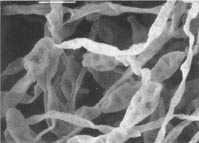  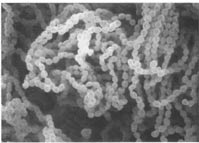
 1100X 1100X 1100X 1100X
 Please fax, mail
or e-mail us (don't call) with your answer. We will draw a winner
from all correct entries received by June 6. The correct answer
and the winner will be published in the next issue Of Materials
Interest. Please fax, mail
or e-mail us (don't call) with your answer. We will draw a winner
from all correct entries received by June 6. The correct answer
and the winner will be published in the next issue Of Materials
Interest.
 The prize is
a $50 restaurant gift certificate, so put on your thinking caps. The prize is
a $50 restaurant gift certificate, so put on your thinking caps.
Results:
 Last issue, we
had many correct entries, with many people having seen the photographs
published in magazines like Popular Science in the past. The photographs
show the surface of a compact disk. The pattern of "bumps and
flats" are the 0's and 1's of the digital code. Last issue, we
had many correct entries, with many people having seen the photographs
published in magazines like Popular Science in the past. The photographs
show the surface of a compact disk. The pattern of "bumps and
flats" are the 0's and 1's of the digital code.
 Our winner, drawn
at random from the correct entries, was Tom Hansel of Pacific Bearing
in Rockford, Illinois. His efforts earned he and his wife a nice
dinner at JMK Nippon Japanese Restaurant in Rockford. Pacific Bearing
is the manufacturer of the Simplicity (TM) line of linear plane
bearings, considered as the finest made. They also carry numerous
other linear motion technology products. They sell direct to OEMs
and through distributors, and their products are available throughout
the world. You may have seen the Pacific Bearing adds in magazines
like Machine Design and Design News, and they had a big display
at the Design Engineering Show at McCormick Plaza in Chicago this
spring. Our winner, drawn
at random from the correct entries, was Tom Hansel of Pacific Bearing
in Rockford, Illinois. His efforts earned he and his wife a nice
dinner at JMK Nippon Japanese Restaurant in Rockford. Pacific Bearing
is the manufacturer of the Simplicity (TM) line of linear plane
bearings, considered as the finest made. They also carry numerous
other linear motion technology products. They sell direct to OEMs
and through distributors, and their products are available throughout
the world. You may have seen the Pacific Bearing adds in magazines
like Machine Design and Design News, and they had a big display
at the Design Engineering Show at McCormick Plaza in Chicago this
spring.
 Congratulations,
Tom. Congratulations,
Tom. |
  Next:
1999 Fall Newsletter Next:
1999 Fall Newsletter |
 |
 |
 |
 |
|






